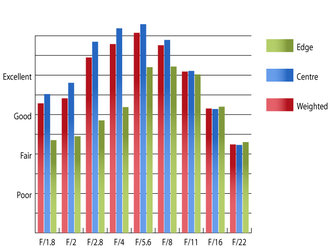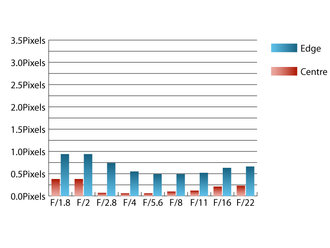Sony NEX 50mm f/1.8 OSS Lens Review
Sony NEX 50mm f/1.8 OSS Performance
At f/1.8, sharpness in the centre of the frame is already very good, although the clarity towards the edges of the frame falls behind somewhat, only achieving fairly good levels. Stopping down improves sharpness across the frame, although the clarity towards the edges of the frame doesn't achieve good levels until the lens is stopped down to f/4, continuing to f/5.6 results in excellent sharpness towards the edges of the frame with outstanding sharpness in the centre.  Resolution at 50mm | How to read our chartsThe blue column represents readings from the centre of the picture frame at the various apertures and the green is from the edges. Averaging them out gives the red weighted column.The scale on the left side is an indication of actual image resolution. The taller the column, the better the lens performance. Simple. For this review, the lens was tested on a Sony NEX-5R using Imatest. |
Chromatic aberrations are more prominent than you may expect from a 50mm lens, especially at fast apertures and towards the edges of the frame. Fringing of 0.94 pixel widths can be seen towards the edges at f/1.8, which will become visible along high contrast edges near the edges of the frame.
 Chromatic aberration at 50mm | How to read our chartsChromatic aberration is the lens' inability to focus on the sensor or film all colours of visible light at the same point. Severe chromatic aberration gives a noticeable fringing or a halo effect around sharp edges within the picture. It can be cured in software.Apochromatic lenses have special lens elements (aspheric, extra-low dispersion etc) to minimize the problem, hence they usually cost more. For this review, the lens was tested on a Sony NEX-5R using Imatest. |
Falloff of illumination towards the corners of the frame is extremely well controlled for a fast aperture lens. At f/1.8 the corners are 1.08 stops darker than the centre and visually uniform illumination is achieved with the aperture stopped down to f/2.8 or beyond.
Moderate levels of pincushion distortion are present, which should pose too many issues during normal picture taking. If absolutely straight lines are of the utmost importance, then the 1.76% pincushion distortion should be relatively easy to correct as the distortion pattern is uniform across the frame.
The supplied lens hood does an excellent job of shielding the lens from extraneous light that may cause issues with flare. Even without the hood this lens is very resistant to flare and produces good contrast, even when shooting into the light.
Add your message
Login required
Please login here or if you've not registered, you can register here. Registering is safe, quick and free.
Please login here or if you've not registered, you can register here. Registering is safe, quick and free.
photodo Stats
1102 lenses
428 MTF tests
74 in-depth photodo reviews
100+ users join each day
Help the lens community by reviewing or rating a lens today via our lens search
428 MTF tests
74 in-depth photodo reviews
100+ users join each day
Help the lens community by reviewing or rating a lens today via our lens search
Latest Lens Reviews
- Chinon 28mm f/2.8 Vintage Lens Review
- Canon EF 70-200mm f/4L IS II USM Lens Review
- Samyang AF 85mm f/1.4 EF Review
- Sigma 70mm f/2.8 DG Macro Art Review
- Samyang AF 24mm f/2.8 FE Review
- Meike 50mm f/1.7 Review
- Tamron 70-210mm f/4 Di VC USD Review
- Lensbaby Burnside 35mm f/2.8 Review
- Asahi Super Takumar 50mm f/1.4 Review
- Asahi Super-Multi-Coated Takumar 135mm f/3.5 Review
